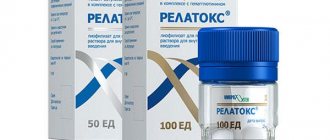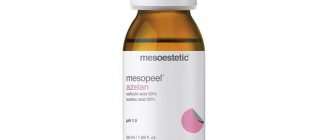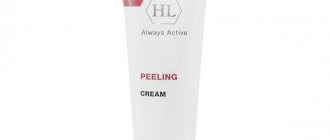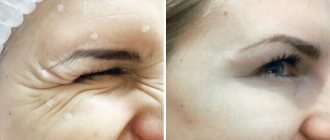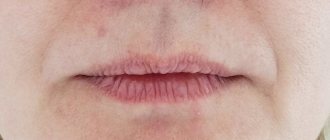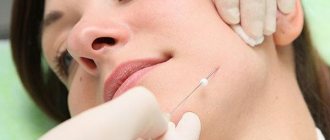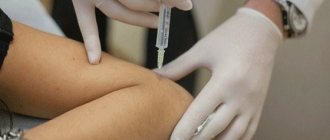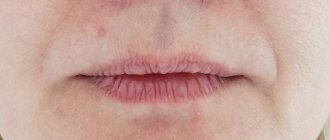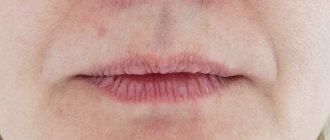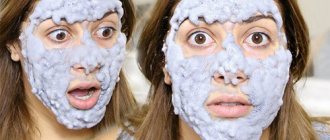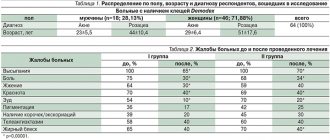Consultation Services Doctors Results Reviews
Expert tested
Sharubina Karina Petrovna Trichologist, dermatovenerologist, cosmetologist
Publication date: November 16, 2022
Review date: November 02, 2022
Cuperosis is a condition characterized by impaired blood circulation in the upper layer of the skin. Blood stagnation leads to thinning of the capillary walls due to the heavy load on them. They become fragile and brittle. Capillaries may periodically burst, and the blood coming out of them will be noticeable under the skin. Most often, rosacea occurs on the forehead, wings of the nose, chin, and cheeks. It is usually accompanied by burning or itching of the skin.
In a more advanced stage, rosacea is characterized by the appearance of a vascular network (telangiectasia) that occurs in the area of capillary damage. Couperosis is the initial stage of circulatory disorders, and rosacea is already a chronic skin disease. 10 percent of our planet's population is affected by this disease. At the same time, the disease is much more common in women, although men are more likely to have complicated forms and rapid development of symptoms.
At the first signs of circulatory problems, you should immediately seek help from specialists. After all, treating the initial stages is always easier than the advanced ones.
Avdeyuk Elena Vladimirovna
Dermatovenerologist, cosmetologist
Signs of development of vascular disorders
Facial redness
This is the initial stage of vascular disorders, which is called erythrosis. Occurs under certain circumstances and provoking factors. Sometimes it appears for no reason. The wings of the nose, cheeks and chin are most prone to the onset of the disease. The sensitivity of the skin in these areas increases and it becomes red. A sick person complains of fever, itching, and tingling. This state can last from a couple of minutes to two hours. This skin pathology on the face can spread to the neck.
Constant redness
In problem areas there is already a constant state of redness of the skin. Spider veins and stars begin to appear, as well as pigmentation.
This condition is similar to a flush or sunburn that does not go away.
Skin changes
The skin becomes thinner, dries out, and has a grayish color. Inflammation begins in problem areas, sometimes they become covered with a rash. The disease progresses gradually and its third stage without treatment occurs 20-30 years from the onset of the pathology.
On the severity of the disease in men and women
Such a diagnosis as rhinophyma is typical mainly for men. As for the papulopustular and abscess forms of rosacea, more severe forms are also more common in men (by the way, as with acne), but this is more likely due to a woman’s desire for beauty and an earlier visit to the doctor.
Often patients, mostly women, with the so-called steroid-induced form of rosacea come to see a dermatocosmetologist. This form develops against the background of long-term treatment with corticosteroid ointments prescribed by dermatologists. Patients, encouraged by the quick effect after using steroid ointments (blanching, relieving itching, resorption of papules, etc.), continue self-treatment for months and even years, without contacting doctors. It is quite difficult to treat such patients, since after stopping the use of steroid ointments, a “withdrawal symptom” occurs: a sharp exacerbation of the disease (the appearance of severe redness and itching).
When treating steroid-provoked rosacea, the abolition of external steroid medications is carried out gradually with partial replacement or alternation with medicinal cosmetics. For example, a good effect is achieved by external use of medicinal cosmetics containing Zn, in particular Cu-Zn cream, spray (Uriage) after Sensibio lotion (Bioderma) instead of washing.
Causes of the occurrence and development of rosacea
Before starting therapy aimed at curing rosacea, it is advisable to find out what could have been the impetus for its occurrence, that is, dilation of blood vessels and loss of elasticity. As a rule, there are two main reasons: hereditary predisposition and motivating external factors.
The mechanisms of inheritance of the disease have not been established, but studies conducted by American scientists have proven that in 40% of cases the disease occurs in close relatives of patients.
But if heredity is difficult to change, then you need to pay special attention to external factors and, if possible, try to avoid them. Or minimize it. Such negative external factors include:
Frequent consumption of alcoholic beverages. Red wine has a vasodilating effect on the skin. This negatively affects the skin of the face.
Eating very hot or spicy foods, which leads to capillary fragility.
Sudden temperature changes. People should avoid prolonged stay in an area with an aggressive climate and avoid temperature changes. This is when, for example, a well-warmed person (after a bath or intense workout) plunges into cold water.
Ultraviolet rays also have a negative effect on the skin. Direct sunlight or prolonged stay in a solarium destroys the capillaries on the surface of the face.
Aggressive products. These include hot chocolate and coffee. They increase blood flow to the surface of the face.
Stress, emotional swings, nervous breakdowns. They increase blood pressure and negatively affect blood vessels.
There are also a number of diseases that provoke changes in blood vessels. These include: diseases of the gastrointestinal tract, especially the stomach and duodenum (they are observed in 90% of patients with rosacea); endocrine diseases; disruptions in the immune system; disorders in the blood coagulation system; vegetative-vascular dystonia; skin infections.
Treatment of concomitant diseases and disorders in patients with rosacea
Treatment of concomitant diseases or elimination of provoking factors are one of the key stages in the management of patients with rosacea [1].
Hormonal disorders
Apparently, the manifestations of the vascular component in rosacea are largely due to hormonal disorders. The complex of hormonal influences on the condition of blood vessels (estrogens, progesterone, etc.) is well known. In particular, increased blood flow in the facial skin, as well as venous stasis, can cause persistent erythema, which explains the frequency of rosacea in middle and older age groups in women [2]. Hormonal examination and consultation with a gynecologist-endocrinologist is an important step in the rosacea treatment program.
At the same time, dermatologists prescribe external products containing vitamin K, ascorbic acid and other drugs to strengthen the vascular wall, as well as agents that improve lymphatic drainage (for example, caffeine derivatives).
Disturbance of intestinal microbiocenosis - dysbiosis
Dysbiosis, a pathological condition of the intestinal flora, has been found to influence the course of rosacea. The main localization of rosacea is the central areas of the face. A parallel can be drawn with juvenile T-shaped acne, where there is a similar localization of the rashes, and in which gastrointestinal pathology is detected. The role of dysbiosis in rosacea, its identification and correction is an important issue that requires a separate serious discussion.
I would like to draw your attention to the fact that dermatologists, when jointly managing dermatological patients with a gastroenterologist, sometimes encounter superficial, ineffective treatment of dysbiosis.
According to gastroenterologist Professor Shatikhin, dysbiosis is very often treated without taking into account or diagnosing the underlying pathology or the true nature of changes in microbiocenosis. The selection of therapy is carried out empirically. The result is low effectiveness of treatment [3]. And for dermatologists, this means a decrease in the results of treatment of skin pathologies or unstable remission.
Infectious diseases (helminthiasis, giardiasis)
According to WHO, the number of patients with intestinal helminthiases, the most common socially significant infectious diseases, reaches 1.4 billion people per year. In Russia, about 2 million patients with parasitic diseases are registered annually [4]. The number of clinically significant species of parasites, including intestinal protozoa, in particular Giardia, is increasing [5].
Treatment of giardiasis in complex therapy of acne and rosacea provides not only a faster clinical effect, but also stable remission of the disease [6].
Metronidazole
, a nitroimidazole derivative, which is the drug of choice in the treatment of trichomoniasis, amebiasis and giardiasis, has long established itself as an effective remedy in the treatment of rosacea.
There is still no consensus on the mechanism of action of the drug, and it is not clear which of its pharmacodynamic properties plays a leading role in achieving a clinical effect in the treatment of rosacea. It has been established that metronidazole enhances the protective and regenerative functions of the mucous membrane of the stomach and intestines, and also has a pronounced anti-edematous effect [7]. The drug provides a bacteriostatic effect against gram-negative anaerobic bacilli, Giardia, as well as an antiparasitic effect against Demodex folliculorum
.
Evidence that metronidazole, when administered systemically, has a suppressive effect on Demodex folliculorum
on the skin, has not yet been confirmed. Local use of drugs (lotions, gels) with metronidazole is quite effective.
Individual food intolerance
In recent years, there have been reports of good results in the treatment of a number of skin diseases using a diet that consists of excluding for a certain period a number of foods to which there is an individual intolerance. Food intolerance is often asymptomatic. In this case, the body receives products that it cannot fully process, which leads to a decrease in immune defense.
Immune status disorders (allergies, autoimmune thyroid pathology)
Allergic concept of rosacea.
With the development of rosacea, manifestations of sensitization to certain products, to
Demodex folliculorum
, helminths and protozoa, to the bacterial flora of the intestine, to fungi of the genus
Candida
, etc., are not excluded. The disease is most severe in the case of autoimmune pathology of the thyroid gland.
Prescribing antihistamines and homeopathic medications with simultaneous treatment by appropriate specialists
reduces the degree of allergic reaction and increases the effectiveness of rosacea treatment.
Nervous system disorders
Psychological stress, vegetoneurosis, excessive emotionality, and vulnerability often accompany patients with rosacea and require separate mandatory correction, including using traditional methods: homeopathy, hirudotherapy, bioresonance therapy, etc.
Reflex reaction of the skin
The energy connections between the skin and internal organs and the spine are taken into account. The reaction of “nerve irritation” (from mesotherapy, massage, ozone therapy, etc.) from the skin is carried out along nerve pathways to the pathological focus in a particular organ. This connection, of course, also works in the opposite direction. Therefore, for any skin disease or disorder, it is necessary to exclude a reflex reaction when dermatological manifestations serve as a signal of a disorder or disease of any internal organ. If we are talking about such a case, the internal organ should be treated. Skin symptoms will go away faster or disappear on their own [8]. At the same time, we see a good effect when using antihomotoxic (homeopathic) complexes
: Traumel comp., Zeel comp., Coensim comp., Ubichinon comp., Cutis comp., Discus comp. and etc.
Treatment methods for rosacea and rosacea
Vascular manifestations on the skin are successfully treated. There are cosmetic procedures that effectively affect dilated and fragile blood vessels. Even with hereditary pathologies.
Laser treatment of rosacea
Doctors at A Clinic recommend a photorejuvenation procedure to effectively eliminate rosacea.
The technique is based on the technology of high-intensity pulsed light (Intensive Pulse Light), where the source is a flash lamp that produces light radiation in the wavelength range from 500 to 1200 nm. The wavelength of the light beam depends on the result that is planned to be achieved. There are three types of effects: on the superficial, middle, and deep layers of the skin.
During photorejuvenation, light beams are directed at vascular formations, as a result of which the hemoglobin that stagnates in them is destroyed (collapses), and the vascular pattern disappears.
According to research from the Cornell University Medical School (USA), satisfaction with the results of photorejuvenation was 92%, while patients underwent a course of five procedures with an interval of 3 weeks between each. The same studies have shown that with photorejuvenation, not only skin defects go away, but also overall skin rejuvenation occurs. Thus, skin elasticity increases by 60%, wrinkle depth is reduced by 70%, pores are narrowed by 65%.
Photorejuvenation also eliminates post-acne, age spots, and acne. This additional cosmetic effect is one of the advantages of this procedure.
The photorejuvenation procedure is completely safe, painless, and does not leave any marks on the skin. Phototherapy does not require a rehabilitation period - it is enough to avoid direct sunlight and tanning for some time.
To get rid of rosacea, 3-5 photorejuvenation procedures with an interval of three weeks are enough.
Treatment methods for rosacea as an underlying disease
Phototherapy
- Photodynamic therapy (PDT)
is one of the new therapeutic technologies for the treatment of various forms of acne, including rosacea [9]. - Photopneumotherapy
is a type of PDT and also has a good therapeutic effect in the vascular stage of rosacea: after the first session, the severity of hyperemia and vascular pattern decreases [10]. However, in 23% of cases, so-called photosensitive forms of rosacea occur, when the manifestation of rosacea is observed at the first rays of the spring sun; such patients are not recommended to use phototherapeutic techniques.
Cosmetology procedures
Masks, some injection methods, etc. are aimed at improving the condition of the superficial vessels of the skin, microcurrent therapy is aimed at providing lymphatic drainage.
Diathermocoagulation
Unlike acne, where the opening of inflamed and non-inflamed sebaceous cysts leads to a rapid therapeutic effect and clinical remission, with rosacea, as a rule, there are no cystic cavitary elements, the papule is dense. We use diathermocoagulation for rosacea only in relation to individual telangiectasias after the removal of acute inflammatory phenomena and reduction of swelling and diffuse hyperemia of the facial skin.
Changes in the sebaceous glands, their enlargement with the formation of sebaceous cysts are characteristic of acne (acne vulgaris). The vascular and initial stages of papular rosacea occur without involvement of the sebaceous gland. In a later period, with long-term, protracted complicated forms of rosacea, the sebaceous gland becomes activated with the formation of cysts. Apparently, due to chronic inflammation, local stimulation of androgen receptors in the skin occurs. In these cases, diathermocoagulation of cystic elements is quite effective.
Local preparations
Gel Skinoren 15%
. For topical treatment of rosacea, there is a smaller range of topical medications available than for the treatment of acne. The direction of action of drugs for rosacea: vasoconstrictor, anti-inflammatory, antibacterial, anti-demodex. In recent years, Skinoren gel with 15% azelaic acid has been successfully used for rosacea. The effectiveness of Skinoren for rosacea reaches 90%. Some doctors and patients are concerned about a slight burning sensation, irritation or minor aggravation of the skin when starting treatment with Skinoren, and they discontinue this drug. Indeed, these side effects may occur if the drug is prescribed too early. In these cases, we usually interrupt the use of Skinoren for 2-3 weeks and continue treating rosacea with classical methods. Then Skinoren gel 15% is re-prescribed for 2-3 months until clinical remission occurs. The previously described adverse reactions do not recur.
Sulfur-containing gel Delex-acne
. The sulfur-containing gel Delex-acne has been shown to have good therapeutic effectiveness for acne and rosacea. The active principle of the gel - activated sulfur in combination with anti-inflammatory plant extracts (nettle, calendula) - prevents the increase in greasiness, has antibacterial, anti-inflammatory and anti-demodectic effects [11].
Roaccutane
Recently, there has been a tendency to expand the indications for the systemic use of isotretinoin (Roaccutane) in the treatment of rosacea. This drug is an effective treatment for severe forms of rosacea. Despite drier and more sensitive skin, patients with rosacea tolerate Roaccutane well. Side effects in the form of dryness and irritation when using it are no more pronounced than in patients with acne. True, you cannot do without specific skin care while taking Roaccutane, which reduces external side effects to zero.
It is important to note that the appointment of Roaccutane should be planned already at the first visit of a patient with acne or rosacea, if there are appropriate indications, for example, for patients with long-term severe widespread forms of rash (cystic and atheromatous), who, as a rule, have already been treated with antibiotics, but with a temporary effect. We believe that physician concerns about drug toxicity do not justify delaying its use in these patients. Comparing the effect of roaccutane and antibiotics on the body, we can say that the severity of the side effects of antibiotics is no less, if not more, than that of roaccutane. Retinoids have been described to act on the etiological factor of rosacea, vascular endothelial growth factor (VEGF), by reducing its activity [12]. Considering the suppressive effect of retinoids on VEGF, it is advisable to conduct broader studies of the therapeutic effect of roaccutane on the vascular stage of rosacea.
Mesotherapy
Mesotherapy must be carried out taking into account the visceral cutaneous zones of reflex projection, since in the acute and subacute state of this disease, injections into the facial skin are too aggressive.
Basic naturopathic therapy
The use of naturopathic therapy in combination with classical methods or alone (for mild disorders) can be very beneficial for any dermatological patient, including those with rosacea. The main stages of basic naturopathic therapy are detoxification, stabilization, and recovery. Additionally, specially individually selected treatment methods are prescribed, for example, correction of the psycho-emotional state with homeopathic medications, reflexology, hirudotherapy, etc. [8].
Hirudotherapy
In our practice, the use of this method has proven to be very effective not only in the acute and subacute stages of rosacea, but also during the rehabilitation period. Hirudotherapy sessions were carried out once a week, a course of 5–10 procedures. The number of leeches used per session was small (4–7 pieces). The procedures were well tolerated in all patients. The reduction in redness on the face was noticeable from the first procedure. Well-being and sleep improved, and patients became calmer. The maximum clinical effect on the face was achieved after 6–7 procedures. The effect of hirudotherapy is complex and consists of several factors: reflex, mechanical and biological [13].
This method allows you to eliminate venous congestion and increase blood supply. In addition, substances that have analgesic and anti-inflammatory effects enter the bloodstream. For example, the enzyme hirudin, secreted by a leech, helps reduce blood viscosity. As a result, blood microcirculation improves and facial swelling decreases. Another leech enzyme, hyaluronidase, depolymerizes hyaluronic acid molecules, “dissolving” the intercellular cement. Third, collagenase actively breaks down pathological collagen, which at the clinical level is manifested in regression of hypertrophic scars and softening of fibrotic connective tissue.
Homeopathy
Endocrinologists often do not find significant endocrine pathology in patients with rosacea that requires hormone replacement therapy. Classical homeopathy as a regulatory therapy is especially effective for endocrine pathologies. Homeopathic medicines for the treatment of the gastrointestinal tract help gastroenterologists obtain an earlier and more lasting effect from treatment. And, of course, the role of homeopathic remedies in regulating the psycho-emotional status, which is so important for rosacea, is invaluable.
Modern homeopathy and antihomotoxic drugs are an effective direction in medicine. Homeopathic complexes allow doctors of all specialties to use them in their practice. Detoxification therapy with these drugs allows you to achieve faster positive dynamics in treatment. These are the drugs Traumel comp., Coensim comp., Ubichinon comp., Limphomiosot comp., Cutis comp. and etc.
Oxygen-ozone therapy
Low concentrations of ozone are used in medicine. It has an antibacterial effect, is a catalyst, stimulates redox processes, improves the synthesis of biologically active substances. Ozone stimulates the immune system, especially the phagocytic protective function, increasing it 4 times. Restores metabolic processes in affected tissues, reduces or eliminates inflammation. To treat rosacea, subcutaneous administration of an oxygen-ozone mixture is used starting 2–3 weeks of treatment after the acute inflammatory phenomena have subsided. The course of treatment averages from 3–4 to 10 procedures 1–2 times a week. As a result of ozone therapy, swelling of facial tissues, congestive hyperemia, which is characteristic of rosacea, and partially small telangiectasias disappear (larger ones are later removed by diathermocoagulation). In the papular stage of rosacea, papules resolve faster. After a course of oxygen-ozone therapy, the likelihood of relapses decreases. During the period of remission, to restore the color, quality of the skin, and eliminate stagnant spots, maintenance oxygen-ozone therapy is carried out: 2-3 times a month, followed by lymphatic drainage massage.
Cryomassage
During cryomassage, as a result of the surface action of liquid nitrogen, a narrowing (vasoconstriction) of blood vessels occurs, followed by expansion (vasodilation) of not only active but also reserve capillaries, which significantly increases blood flow to the skin tissues and improves their trophism. Lymphatic drainage and immunomodulatory effects are noted, cellular metabolism and regenerative processes are activated [14]. Cryotherapy for rosacea is indicated regardless of the stage of the disease. The intensity of cryomassage depends on the form of rosacea and skin type.
Mesobotox against rosacea
Botulinum toxin, getting under the skin, begins to affect the hormone serotonin, as well as ion channels responsible for the appearance of many signs of rosacea (the effect of dilated blood vessels) and its chronic form - rosacea.
This allows you to normalize neurovascular disorders and, thereby, reduce the severity of redness and uneven skin texture. Botulinum toxin also has the ability to reduce the hyperactivity of subcutaneous vessels and normalize blood microcirculation in them. This leads to a decrease in persistent erythema and a significant decrease in the intensity of redness as a result of sudden flushes of blood to the face, which often occur in patients with rosacea during physical activity, stress, exposure to hot water, wind, frost and other negative factors.
Introduction
Firstly, many believe that even persistent erythema is not a reason to see a doctor, and the first visit to a specialist for treatment is sometimes associated only with an increase in the severity of the disease, with the appearance of papular and nodular elements.
Secondly, for the vast majority, prerosacea is not a problem at all that threatens to turn into something more severe. In special cosmetology literature and among cosmetologists, such skin, which actively reacts with redness to various irritants, including creams and procedures, is designated as sensitive skin, and if along with this there are already isolated telangiectasia, the term rosacea .
Cuperosis is a generally accepted term in cosmetology, as well as sensitive skin and seborrhea. In descriptions of the prescription of medicinal cosmetics, creams, lotions and in indications for cosmetological methods, these terms are most often used for problem skin and help cosmetologists more accurately select medicinal cosmetics and procedures.
The concept of rosacea includes both a condition of relatively normal skin with superficially located vessels - telangiectasia (sometimes this can be regarded as pre-rosacea), and the vascular stage of rosacea with the so-called problematic facial skin.
We often see a superficial network of vessels with very thin, dry, atrophic facial skin. As a rule, such skin is reactive, very sensitive to external influences, and the response is not always predictable. And although the term rosacea is not used in dermatological practice, in cosmetology, where, as a rule, they do not deal with diseases, the use of the concept of rosacea skin is justified.
